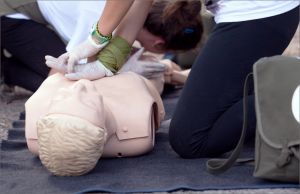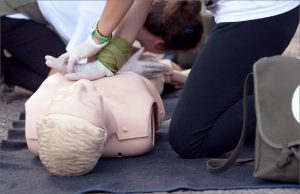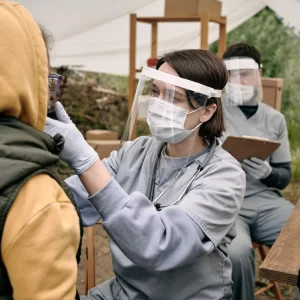
During traumatic incidents when sudden cardiac arrest occurs, the heart stops beating or it beats erratically. More than 1,000 people experience cardiac arrest on a daily basis. In remote or austere environments or during accidents or critical events, automatic external defibrillator (AED) along with cardiopulmonary resuscitation (CPR) provide the solutions that help save lives. Outside the hospital or ambulance, bystanders trained in either or both often assist until emergency medical technicians arrive.
The AED device shocks the heart into restarting. This electric shock occurs during cardiac arrest. The AED helps restore the heart’s functionality making it beat at a normal rhythm. AEDs are designed for use by people with little to no training. As an automated device, it analyzes whether someone’s heart requires a shock to resume beating.
CPR provides another method to help people undergoing sudden cardiac arrest. Minutes matter when this happens. When CPR is administered within four-to-five minutes, there is a chance that the person will survive. If no help arrives, and the heart stops beating for nine minutes, the brain and the rest of the organs are deprived of oxygen. Irreparable and irreversible damages occur when this happens. When someone collapses, call 911 and then immediately begin administration of CPR, followed by use of an AED if one is nearby.
Helping a Victim of Sudden Cardiac Arrest
Knowing when and how to help someone requires training. Having this knowledge begins with basic education from courses taught by the American Heart Association or American Red Cross. Receiving certification for both CPR and AED enable bystanders and lay people to assist prior to arrival by paramedics.
During CPR, the victim’s heart compresses with manual pumping. This ensures that oxygenated blood circulates throughout the body. The American Heart Association suggests that rescue breaths are not as critical as compressions. The compressions during CPR must continue until trained medical personnel arrive. The goal is survival, and being the first on the scene to administer CPR with an AED provides the opportunity to save life.
Before administering CPR or using an AED, there are several signals to check if a person suddenly collapses: the person is not breathing, the person’s heart has stopped, labored breathing that sounds like gasping or snorting, or they are not responding to any stimulus.
Using an AED
The AED describes the function of the device exactly. It is automated for bystanders and lay people to use easily. Instructions are provided in audio and written format when the device is activated.
It is used externally on the chest of the person suffering from sudden cardiac arrest. Anyone using the AED understands that it is strictly an external device. There are some cases where a person is wearing a medical alert bracelet or pacemaker that prohibits use of an AED device.
While CPR provides manual compression to keep blood and oxygen circulating through the body, AED actually restarts the heart by way of the defibrillator shock. This shock helps resume the heart’s normal rhythm. The abnormal beating of a heart is called arrhythmia and tachycardia occurs when the heart beats more rapidly than normal. The AED is advanced technology and has the ability to read a person’s heart rhythm. When abnormal heart rhythm is detected, the machine analyzes whether to administer the electric shock. This means there is no guesswork for a person using the device.
The machine comes with clear instructions. These are both audio and visual instructions with illustrations on how to administer the AED. Even people with no prior training in AEDs can comfortably use the device.
More and more, AEDs are visible in public places including shopping malls, parks, schools, grocery stores, airports, workplaces, and even homes. Having the knowledge on when to assist someone undergoing sudden cardiac arrest is a matter of life and death. AEDs are critical tools, so earning certification and training in CPR and AED offers readiness when it’s most needed. Reach Alleanza to learn more about Automatic External Defibrillator and CPR.


